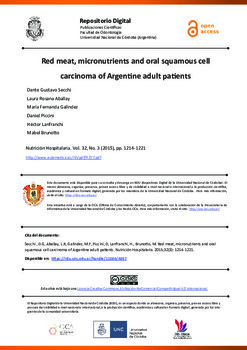| dc.contributor.author | Secchi, D.G. | |
| dc.contributor.author | Aballay, L.R. | |
| dc.contributor.author | Galíndez, M.F. | |
| dc.contributor.author | Piccini, D. | |
| dc.contributor.author | Lanfranchi, H. | |
| dc.contributor.author | Brunotto, M. | |
| dc.date.accessioned | 2017-08-07T17:21:46Z | |
| dc.date.available | 2017-08-07T17:21:46Z | |
| dc.date.issued | 2015 | |
| dc.identifier.citation | Secchi , D.G, Aballay, L.R, Galíndez, M.F, Piccini, D, Lanfranchi, H., Brunotto, M. Red meat, micronutrients and oral squamous cell carcinoma of Argentine adult patients. Nutrición Hospitalaria. 2015;32(3): 1214-1221. | es |
| dc.identifier.issn | 1699-5198 | |
| dc.identifier.uri | http://hdl.handle.net/11086/4897 | |
| dc.description.abstract | Introduction: the identification of risk group of oral cancer allows reducing the typical morbidity and mortality rates of this pathology.
Objetive: it was analyzed the role of red meat, macronutrients and micronutrients on Oral Squamous Cell carcinoma (OSCC) in a case–control study carried out in Cordoba, Argentina.
Methods: case-control study 3:1, both genders, aged 24-80 years. Dietary information was collected using a quali-quantitative food frequency questionnaire. The logistic regression was applied for assessing the association among case/control status and daily red meat/macronutrient/micronutrients/energy intake.
Results: micronutrients and minerals in the diet that showed high significant median values of common consumption in cases relative to controls were iron, phosphorus, vitamins B1, B5, B6, E and K and selenium. The association measurement estimated by logistic regression was showed that a significant association between red meat, fat, daily energy, phosphorous, vitamin B5, vitamin E, and selenium intake and OSCC presence.
Conclusions: a high intake of fats, phosphorus, vitamin B5, vitamin E, and selenium intake and red meat appears to be related to the presence OSCC in Cordoba, Argentina. In relation to red meat consumption and risk of OSCC, the future research should center of attention on reducing the complexity of diet and disease relationships and reducing variability in intake data by standardizing of criteria in order to implement simple strategies in public health for recognizing risk groups of OSCC. | es |
| dc.language.iso | eng | es |
| dc.publisher | Nutrición Hospitalaria. | es |
| dc.rights | Atribución-NoComercial-CompartirIgual 4.0 Internacional | * |
| dc.rights.uri | https://creativecommons.org/licenses/by-nc-sa/4.0/deed.es | * |
| dc.subject | Oral squamous cell carcinoma | es |
| dc.subject | Daily diet | es |
| dc.subject | Argentina | es |
| dc.subject | Red meat | es |
| dc.subject | Micronutrients | es |
| dc.title | Red meat, micronutrients and oral squamous cell carcinoma of Argentine adult patients. | es |
| dc.type | article | es |
| dc.description.version | publishedVersion | es |





